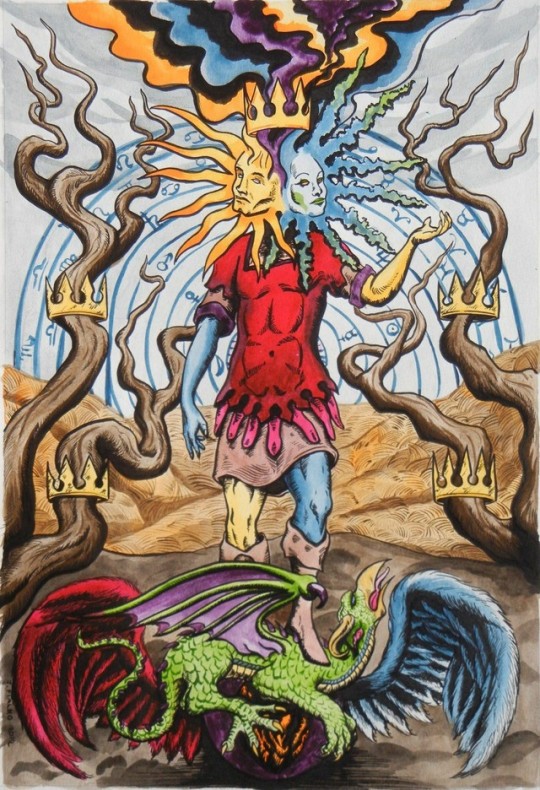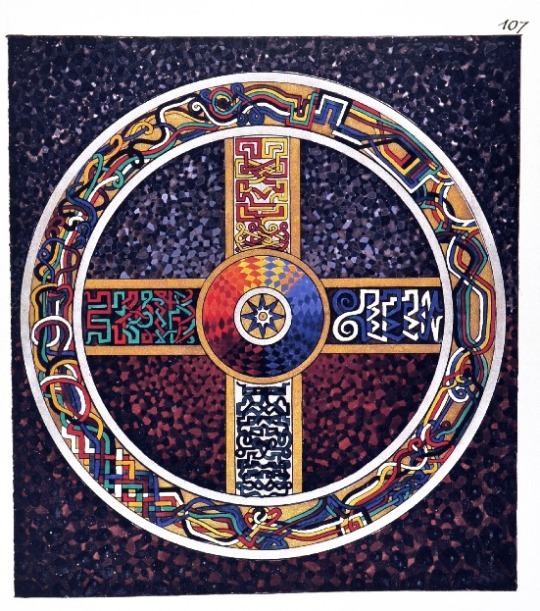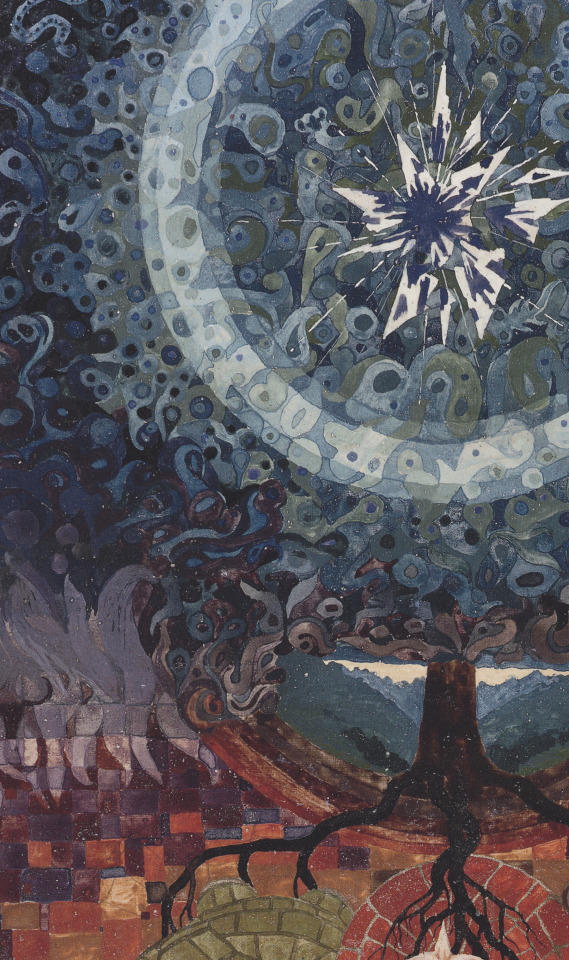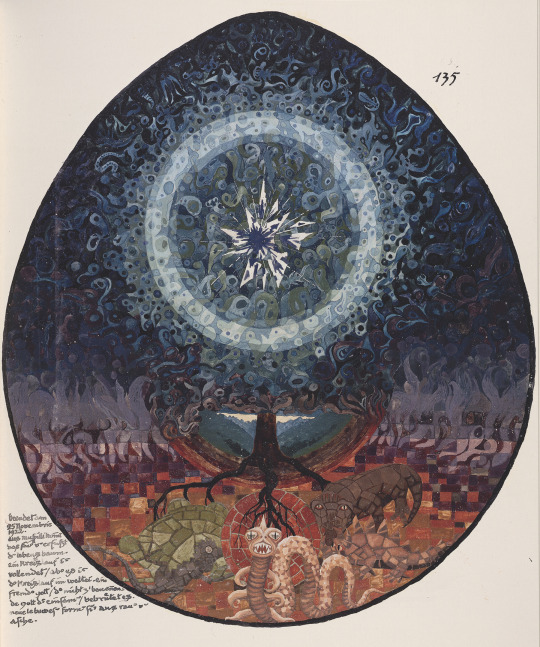Photo

“But if you pay close attention, you will see that the most masculine man has a feminine soul, and the most feminine woman has a masculine soul.”
~ Carl Jung; Liber Novus
1K notes
·
View notes
Text
“If I thus truly imitate Christ, I do not imitate anyone, I emulate no one, but go my own way, and I will also no longer call myself a Christian.”
— Carl Jung, Liber Novus
4 notes
·
View notes
Photo

You should be the vessel and womb of life, therefore I shall purify you.
~Carl Jung to his Ego, Liber Novus, Page 330.
The “eternal” child in man is an indescribable experience, an incongruity, a handicap, and a divine prerogative; an imponderable that determines the ultimate worth or worthlessness of a personality. ~Carl Jung, CW 9i, Para 300
To find out what is truly individual in ourselves, profound reflection is needed; and suddenly we realize how uncommonly difficult the discovery of individuality is. ~Carl Jung, CW 7, Para 242.
The urge and compulsion to self-realization is a law of nature and thus of invincible power, even though its effect, at the start, is insignificant and improbable. ~Carl Jung, CW 9i, Para 289
“All…Mysteries appear to come from the same source, having a complete cosmogony and an explanation of the primitive nature and origin of man. …The Initiate was first subjected to horrifying trials by darkness, fire and water, long fasts, visions, etc., and if he surmounted these and remained sane, which many did not, he was received among the priests.” –Inquire Within (A Ruling Chief of the Mother Temple of the Stella Matutina and R.R. et A.C.), The Trail of the Serpent, p. 12 (1936)
The ego keeps its integrity only if it does not identify with one of the opposites,
and if it understands how to hold the balance between them.
~Carl Jung, CW 8, Para 425.
It is sufficiently obvious that life, like any other process, has a beginning
and an end and that every beginning is also the beginning of the end.
~Carl Jung, CW 7, Para 34.
From the middle of life, only he who is willing to die with life remains living. ~Carl Jung, Liber Novus, Page 274, Footnote 75.
But when we penetrate the depths of the soul and when we try to understand its mysterious life, we shall discern that death is not a meaningless end, the mere vanishing into nothingness—it is an accomplishment, a ripe fruit on the tree of life. ~Carl Jung, CW 18, Para 1705-7
Death is a drawing together of two worlds, not an end.
We are the bridge. ~Carl Jung, J.E.T., Page 95.
Take pains to waken the dead.
Dig deep mines and throw in sacrificial gifts,
so that they reach the dead.
Reflect in good heart upon evil, this is the way to the ascent.
But before the ascent, everything is night and Hell.
~Carl Jung, The Red Book, Page 244.
When you step into your own Hell, never think that you come like one suffering in beauty; or as a proud pariah, but you come like a stupid and curious fool and gaze in wonder at the scraps that have fallen from your table.
~Carl Jung, Liber Novus, Page 262.
The way to your beyond leads through Hell and in fact through your own wholly particular Hell, whose bottom consists of knee-deep rubble, whose air is the spent breath of millions, whose -fires are dwarflike passions, and whose devils are chimerical sign-boards. ~Carl Jung, Liber Novus, Page 262.
The deposit of man’s whole ancestral experience—so rich in emotional imagery—of father, mother, child, husband and wife, of the magic personality, of dangers to body and soul, has exalted this group of archetypes into the supreme regulating principles of religious and even of political life, in unconscious recognition of their tremendous psychic power. ~Carl Jung, CW 8, Para 337
Childhood is important not only because various warpings of instinct have their origin there, but because this is the time when, terrifying or encouraging, those far-seeing dreams and images appear before the soul of the child, shaping his whole destiny, as well as those retrospective intuitions which reach back far beyond the range of childhood experience into the life of our ancestors.
~Carl Jung, CW 8, Para 989-70)
16 notes
·
View notes
Text
On the following night I had to write down all the dreams that I could recollect, true to their wording. The meaning of this act was dark to me. Why all this? Forgive the fuss that rises in me. Yet you want me to do this. What strange things are happening to me? I know too much not to see on what swaying bridges I go. Where are you leading me? Forgive my excessive apprehension, brimful of knowledge. My foot hesitates to follow you. Into what must and darkness does your path lead? Must I also learn to do without meaning? If this is what you demand, then so be it. This hour belongs to you. What is there where there is no meaning? Only nonsense, or madness, it seems to me. Is there also a supreme meaning? Is that your meaning, my soul? I limp after you on crutches of understanding. I am a man and you stride like a God. What torture! I must return to myself, to my smallest things. I saw the things of my soul as small, pitiably small. You force me to see them as large, to make them large. Is that your aim? I follow, but it terrifies me. Hear my doubts, otherwise I cannot follow, since your meaning is a supreme meaning, and your steps are the steps of a God.
– Carl Jung, The Red Book.
22 notes
·
View notes
Text
The moon is dead. Your soul went to the moon, to the preserver of souls. Thus the soul moved toward death. I went into the inner death and saw that outer dying is better than inner death. And I decided to die outside and to live within. For that reason I turned away and sought the place of the inner life.
– Carl Jung, The Red Book.
18 notes
·
View notes
Text
A Brief Account Of The Similarities Between Jungian Psychology And Freemasonry
Article by
Alan Hamilton
The underlying principles of analytical (Jungian) Psychoanalysis are similar to those of Freemasonry.
This spring, I was invited to participate in a golf foursome which included Grand Commander C. Fred Kleinknecht, 33°, his brother Ill. Kenneth S. Kleinknecht, 33°, and my father, Ill. Dwight A. Hamilton, 33°, S.G.I.G. in Colorado. On this occasion, the usual banter that accompanies golf was interwoven with more serious conversations concerning Freemasonry and, given my profession, psychology. The discussions between the Grand Commander and myself began to reveal that we share a similar commitment to the world and to humanity, even though the venues through which we have chosen to pursue these commitments are different. I am not a member of a Masonic Lodge but rather a psychologist who specializes in Jungian psychoanalysis. Although my understanding of Freemasonry is limited, in this article I will give a brief account of how I understand the underlying principles of analytical (Jungian) psychoanalysis to be similar to those of Freemasonry.
Around the turn of the century, Sigmund Freud, the famous Viennese psychologist, developed the field of psychoanalysis on the premise that the primary motivations of all organisms, including human beings, are focused on maintaining a state of satisfaction or homeostasis, i.e., a relatively stable state of equilibrium. Based on this reasoning, Freud arrived at the conclusion that the images and mythologies of all creeds and philosophies are essentially disguised wishes for eventual biological satisfaction or well-being that protect from the frustrations resulting from social and moral restraints. The equally famous Swiss psychologist, Carl Jung (pictured at right), however, took issue with this agnostic perspective of Freud’s, recognizing instead the implicit order that is manifest within the images and mythologies of formal faiths, past and present. In other words, Jung believed that most cultural forms of human expression (religion, architecture, art, literature, folklore, etc.) are manifestations of organizing principles, what he termed archetypes.
Jung believed that these primary patterns or principles, these archetypes, collectively represent the human psyche. These archetypal patterns underlie the processes that constitute individual and social development. Consequently, Jung believed that we are all governed by an intrinsic desire for wholeness or completeness that represents an inherent human aspiration that he considered to be spiritual in nature.
Jung’s break from the empirical tenets established by Freud redefined psychology as the art of recognizing and facilitating fundamental changes throughout life—changes that are usually instigated first on a psychic level within the unconscious. It is often the case that the unconscious stirrings are at first felt consciously as feelings of dissatisfaction, depression, or anxiety. Yet sometimes these symptoms can be traced to an unconscious desire for further development, or what Jung termed “individuation.” The “collective unconscious” is Jung’s term for what underlies and informs personal experience and leads one towards wholeness through experiences of transformation.
Implicit to Jung’s psychology is the trust that life is not merely a random biological phenomenon but, rather, an ordered and meaningful process. On this basis, the many difficult challenges we are confronted with throughout life (trauma, loss, anxiety, depression, despair, disease, etc.) are integral, though difficult, aspects of the transformative operations of the human psyche.
Oftentimes, we mistakenly perceive ourselves as victims of our symptoms and our suffering. Yet the same personal travail is central to most archetypal motifs and mythic patterns. The recognition of the mythic dimensions underlying our own personal experiences breaks down our narcissistic claims to the joys and suffering of life and unites us more genuinely within the process of being human. When we can learn to focus on the shared dynamics of being, rather than the differentiating aspects of personality, empathy is truly possible.
In this respect, I believe the philanthropic goals of Jungian analytical psychology and Freemasonry are alike, insofar as the communal bonds of brotherhood are the consequence of a commitment to our shared human destiny rather than the narcissistic goal of perfecting and maintaining the individual personality.
Analytical psychology and Masonry both require a religious sensibility without being religions themselves. This is a most difficult enterprise, and I imagine the Masonic Lodge is sometimes accused of being a pseudo-religion or cult. For many persons, a spiritual commitment can only exist within the dogmatic structure of a religion. Jungian psychoanalysis, like Masonry, is compatible with all religions because it recognizes that being is itself a phenomenon with spiritual dimensions in which we all participate. Carl Jung sometimes suggested that his patients find appropriate religious participation. In fact, Alcoholics Anonymous developed out of one instance in which Jung prescribed religious participation to an alcoholic patient, recognizing his problem as a spiritual crisis that required the support and containment of a religious structure.
Analytical psychology draws on many different cultural and faith traditions which illustrate the same transformative process of the human being. One of the most important archetypal motifs consistently found in all such mythologies and traditions is the archetype of the “hero” who represents humankind’s trials and transformative potential. These heroes teach us that development and transformation must involve death as well as rebirth. In my work, a familiarity with myths is important because myths offer a reference to the suffering of patients that may otherwise seem arbitrary. The same motifs that appear throughout world literature can be recognized in the personal accounts heard in the consulting room. Consequently, the goal of analysis is not merely towards the restructuring of destructive behavior, or the alleviation of debilitating disorders; rather, the function of analysis is to become more consciously aware of the initiatory processes that may underlie our symptoms. In other words, a symptom is not to be gotten rid of but understood, and myths form a context for this type of understanding.
As we approach the new millennium, one of the cultural symptoms we are experiencing is the breakdown of the sacred; the traditional forms of devotion that have served as the moral foundation of our culture are becoming pulled apart into the extreme positions of different forms of agnosticism and religious fundamentalism. During this difficult period in human history, it is especially important to avoid the tendency towards religious and secular polarization by maintaining an awareness that the sacred is implicit to all human experience. By living we participate in a sacred process that requires, above all else, recognition of it as such.
True philanthropy and true therapy exist within the recognition that we are all participants in a collective process that often transcends our own limited understanding and beliefs. In this respect, I believe Masonry represents an outstanding model of philanthropy because the gifts that Masons offer the world in the form of charities and donations are not gifted from a position of superiority but, rather, from a position of humility and brotherhood—the result, perhaps, of working through the many Masonic Degrees.
The therapeutic process is also an initiatory process; there are many stages or degrees through which the analyst and analysand (patient) must travel together. Ultimately, I imagine that Jungian analysis and Freemasonry aspire towards the same goal, of claiming the joys and sorrows of life and death as meaningful processes of being a whole human being—a claim from which true compassion springs.
Dr. Alan Hamilton
is a psychotherapist in private practice in Santa Fe, New Mexico, where he lives with his wife and two daughters. He is presently training to become a certified Jungian Analyst and is working toward his licensure as a Clinical Psychologist.
6 notes
·
View notes
Text
“Let’s talk about the personal shadow first. When we were one or two years old we had what we might visualize as a 360-degree personality. … but one day we noticed that our parents didn’t like certain parts of that ball. They said things like: “Can’t you be still?” Or “It isn’t nice to try and kill your brother.” Behind us we have an invisible bag, and the part of us our parents don’t like, we, to keep our parents’ love, put in the bag. By the time we go to school our bag is quite large. Then our teachers have their say: “Good children don’t get angry over such little things.” So we take our anger and put it in the bag. By the time my brother and I were twelve in Madison, Minnesota we were known as “the nice Bly boys.” Our bags were already a mile long. Then we do a lot of bag-stuffing in high school. This time it’s no longer the evil grownups that pressure us, but people our own age. So the student’s paranoia about grownups can be misplaced. I lied all through high school automatically to try to be more like the basketball players. Any part of myself that was a little slow went into the bag. My sons are going through the process now; I watched my daughters, who were older, experience it. I noticed with dismay how much they put into the bag, but there was nothing their mother or I could do about it. So I maintain that out of a round globe of energy that twenty-year-old ends up with a slice… We spend our life until we’re twenty deciding what parts of ourself to put into the bag, and we spend the rest of our lives trying to get them out again.”
— robert bly, “a little book on the human shadow”
45 notes
·
View notes
Text
“But the spirit of the depths said: ‘No one can or should halt sacrifice. Sacrifice is not destruction, sacrifice is the foundation stone of what is to come. Have you not had monasteries? Have not countless thousands gone into the desert? You should carry the monastery in yourself. The desert is within you…’”
— c.g. jung the red book: liber primus fol. i(v)
15 notes
·
View notes
Text
“Is it possible, in the final analysis, for one human being to achieve perfect understanding of another? We can invest enormous time and energy in serious efforts to know another person, but in the end, how close can we come to that person’s essence? We convince ourselves that we know the other person well, but do we really know anything important about anyone? Haruki Murakami, The Wind-Up Bird Chronicle”
—
4 notes
·
View notes
Text
For maybe it seems that the inbetweens of my dreams reams me of the truth. Freeing association to things of falsifications that the complexities have shrouded. Let not my mind be clouded, for though I’ve doubted myself. For we all are to find wealth in our own minds health.
C.G
5 notes
·
View notes
Text
Carl Jung on the Artist
The artist is not a person endowed with free will who seeks his own ends, but one who allows art to realize its purposes through him. As a human being he may have moods and a will and personal aims, but as an artist he is “man” in a higher sense - he is “collective man,” a vehicle and molder of the unconscious psychic life of mankind. …
The creative process, so far as we are able to follow it at all, consists in the unconscious activation of an archetypal image and elaborating and shaping the image into the finished work. By giving it shape, the artist translates it into the language of the present and so makes it possible for us to find our way back to the deepest springs of life. …
Therein lies the social significance of art: It is constantly at work educating the spirit of the age, conjuring up the forms in which the age is more lacking. The unsatisfied yearning of the artist reaches back to the primordial image in the unconscious, which is best fitted to compensate the inadequacy and one-sidedness of the present. The artist seizes on this image and, in raising it from deepest unconsciousness, he brings it into relation with conscious values, thereby transforming it until it can be accepted by the minds of his contemporaries according to their powers.
Carl Jung, in his essay Psychology and Literature
11 notes
·
View notes
Text
““Conflict lights the fire of affects and emotions and has two aspects like every fire: namely, combustion and the production of light. Emotion is the alchemistic fire whose warmth makes everything manifest and whose heart burns away all superfluities. It is the moment when steel strikes stone and a spark is produced. For emotion is the chief source of becoming conscious. There is no transformation from dark to light or from inertia to movement without emotion.” C. G. Jung”
—
10 notes
·
View notes
Text
…I myself am a question which is addressed to the world, and I must communicate my answer, for otherwise I am dependent upon the world’s answer.
C.G. Jung
141 notes
·
View notes
Text
“The meeting of two personalities is like the contact of two chemical substances: if there is any reaction, both are transformed.”
— C.G. Jung
89 notes
·
View notes
Text
What Each Cognitive Function Finds Energizing
Se is energized by being very in touch with the tangible environment and “what is” is appreciated for what it is and nothing beyond that.
Si is energized by information from the past coming as a “knowing” that is rich in detail and everything that is connected with that memory comes forward in sequence.
Ne is energized by discovering other perspectives on things and people in an ever-shifting succession of ideas triggered by the particular situation, much like brainstorming.
Ni is energized by transformational visions of how someone can grow and being drawn to make those visions manifest.
Te is energized by organizing space and ideas, putting things in order, and creating some sort of organizing system if one doesn’t already exist.
Ti is energized by delineating categories, articulating principles, and critiquing what is wrong with something.
Fe is energized by creating and maintaining harmonious relationships, securing positive social feedback, building interpersonal intimacy, and helping people feel comfortable and included.
Fi is energized by determining fundamental truths and values that are basis for action, and standing up for these truths is a compelling experience.
***
(Adapted from: Berens, L. V. (1999). Dynamics of personality type: Understanding and applying Jung’s Cognitive Processes.)
118 notes
·
View notes
Photo

What the ancients did for their dead! You seem to believe that you can absolve yourself from the care of the dead, and from the work that they so greatly demand, since what is dead is past. You excuse yourself with your disbelief in the immortality of the soul. Do you think that the dead do not exist because you have’ devised the impossibility of immortality? You believe in your idols of words. The dead produce effects, that is sufficient. In the inner world there is no explaining away, as little as you can explain away the sea in the outer world. You must finally understand your purpose in explaining away, namely to seek protection. I accepted the chaos, and in the following night, my soul approached me.
- writing and artwork by CG Jung, The Red Book
93 notes
·
View notes
Photo


Carl Jung (Swiss, 1875-1961)
Illumination from The Red Book (Liber Novus), 1913-1930
“Everything else is to be derived from this… My entire life consisted in elaborating what had burst forth from the unconscious and flooded me like an enigmatic stream and threatened to break me. That was the stuff and material for more than only one life. Everything later was merely the outer classification, scientific elaboration, and the integration into life. But the numinous beginning, which contained everything, was then.” - C. G. Jung, 1957
For 50 years after Jung’s death, this artwork was locked in a secret vault. It was shown for the first time in 2009.
3K notes
·
View notes